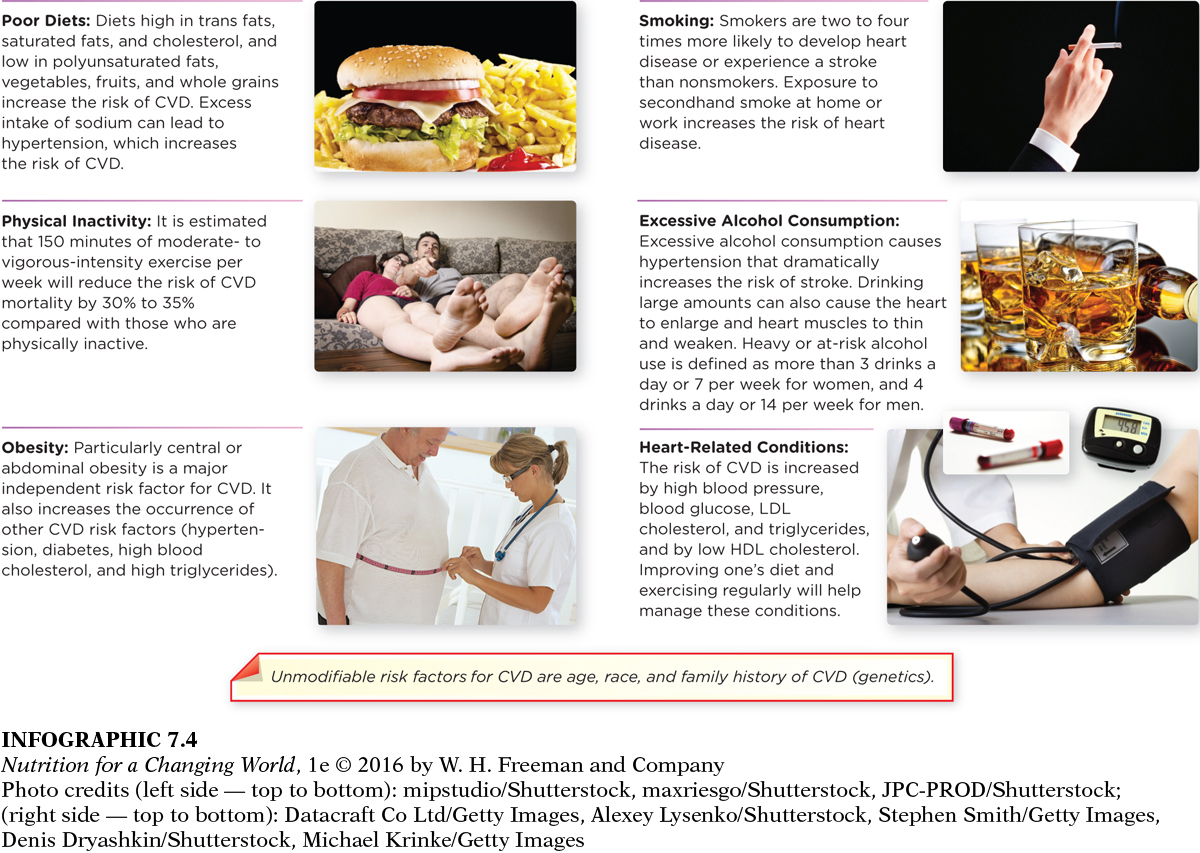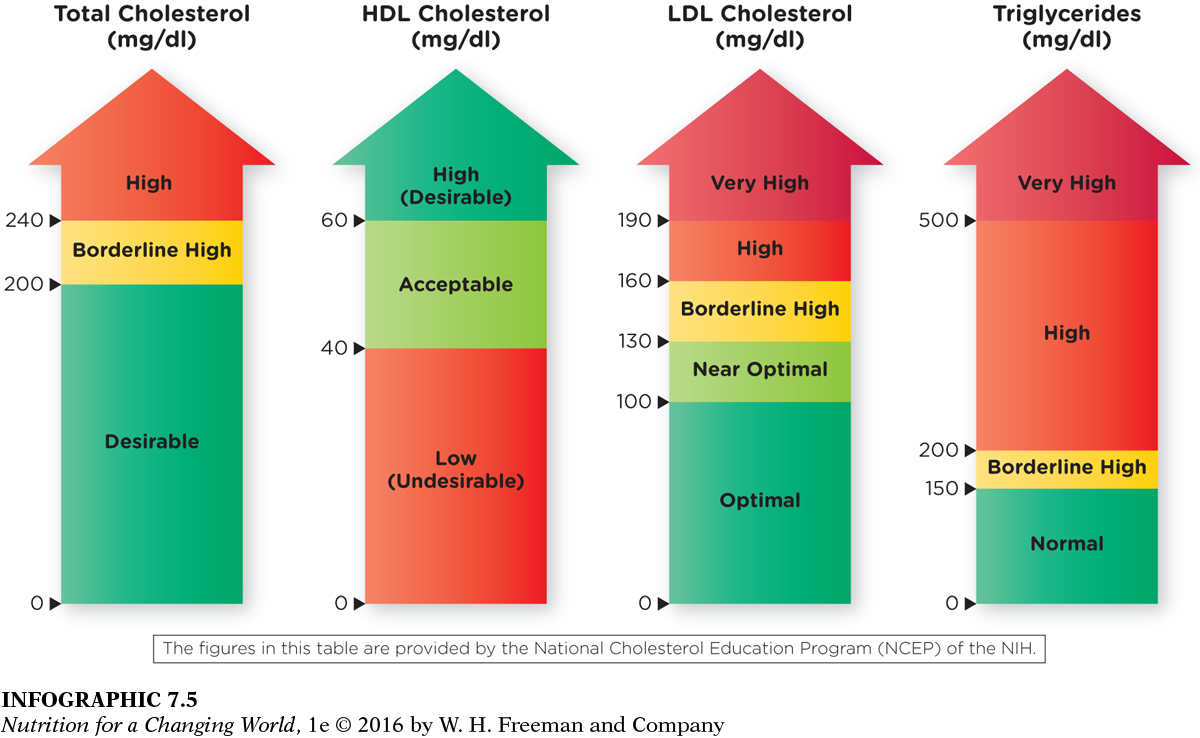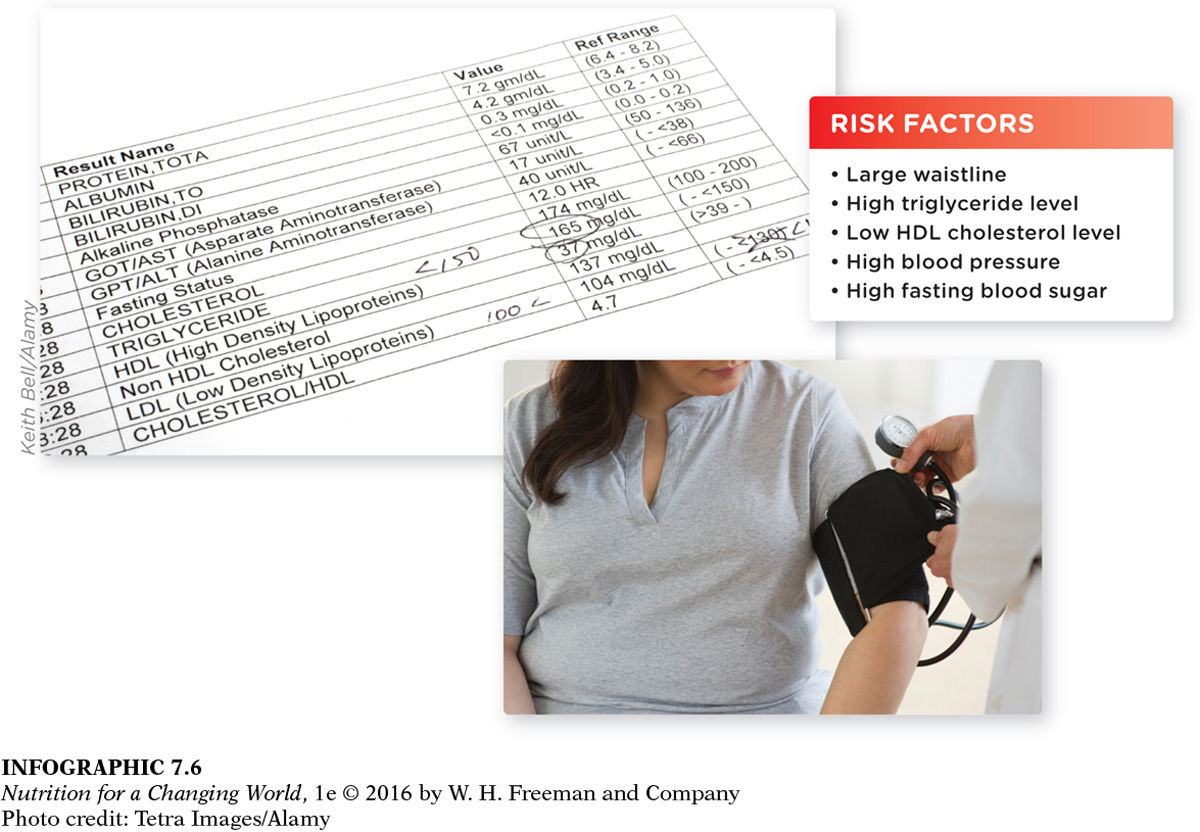RISK FACTORS FOR CARDIOVASCULAR DISEASE
You can’t do anything about some risk factors for CVD. For example, individuals with a family history of heart disease at an early age are more likely to develop CVD, as are African Americans, and both men and women are at increased risk as they age. But there are many risk factors people of all ages can modify, most significantly through diet and exercise.
Modifiable risk factors include smoking; a diet high in saturated and trans fats, cholesterol, sodium, and added sugar; a sedentary lifestyle; obesity; excessive alcohol consumption (see Chapter 19 to learn more about health implications of alcohol consumption); and high blood pressure. Having high blood pressure (hypertension)—a condition in which blood pushes with excessive force against artery walls—

Question 7.3
 If you exercised five days per week, how many minutes would you have to exercise each day to meet the recommendations to reduce your risk of cardiovascular disease?
If you exercised five days per week, how many minutes would you have to exercise each day to meet the recommendations to reduce your risk of cardiovascular disease?
People who engage in 30 minutes of moderate-
Though many risk factors for CVD are modifiable, more than 90% of Americans eat a “poor” diet for heart health, according to the American Heart Association. For example, the concentrations of cholesterol and triglycerides in blood are a major risk factor for CVD. Blood cholesterol levels measuring less than 200 milligrams of cholesterol per deciliter of blood (mg/dl)—the standard units of measurement for cholesterol—
One of the most important tools Berenson and his Bogalusa study team used to evaluate healthy diets was children’s intake of fat and cholesterol. Besides asking kids about their diets, the Bogalusa researchers also directly measured levels of lipids in their blood, by looking at the lipoproteins that transport lipids around the body. Likewise, physicians use a diagnostic test called a lipid panel to provide information about total cholesterol, high-
Recall from Chapter 6 that lipoproteins contain different proportions of proteins, cholesterol, triglycerides, and other components that affect their density and function—
HDLs, in contrast, bring cholesterol from tissues back to the liver, where it is processed and eliminated; not surprisingly, higher levels of HDL have been associated with a lower risk of heart disease. In fact, low levels of HDLs—

Question 7.4
 For which of these values does the risk of heart disease decrease as the value increases?
For which of these values does the risk of heart disease decrease as the value increases?
As HDL cholesterol increases, the risk of heart disease decreases.
METABOLIC SYNDROME a cluster of risk factors associated with the development of cardiovascular disease and type 2 diabetes
In general, the risk for CVD increases with the number of risk factors you have. People who are carrying around a cluster of some of the most dangerous risk factors for CVD are said to have metabolic syndrome. For example, having an elevated blood glucose level is a serious condition, but when coupled with excessive amounts of abdominal fat and high blood pressure, a person has a greater chance of cardiovascular problems because of the combination of risk factors. Not surprisingly, this makes them much more likely to have a heart attack or stroke, and five times more likely to develop type 2 diabetes. To be given a diagnosis of metabolic syndrome individuals must have at least three of the following problems: excessive abdominal fat, high blood pressure, elevated levels of triglycerides in the blood, low levels of HDL, and elevated blood glucose levels (either prediabetes or type 2 diabetes—

Question 7.5
 What is considered a normal triglyceride level?
What is considered a normal triglyceride level?
A normal triglyceride level is less than 150 mg/dL.
■ ■ ■
To learn more about the development of CVD, pathologist William Newman and a colleague would drive the 66 miles up from Louisiana State University School of Medicine in New Orleans to Bogalusa to perform the autopsy whenever a young person in Bogalusa died. What Newman and his colleagues saw when they opened the hearts of the young people shocked them.
Although most people think of heart disease as something that affects adults, virtually all of the young people of Bogalusa already had fatty streaks—the precursors to plaques—
To quantify the extent of atherosclerosis, each pathologist would look at every autopsy specimen and assign the stained fatty streaks a score, and the scores were then averaged together. The study was blinded, so the pathologists didn’t know the source of the tissues beforehand.
The researchers then compared the results of those autopsies with data collected from young people during the study, and identified a number of risk factors associated with the risk of early atherosclerosis: smoking, obesity, hypertension, and high levels of cholesterol and triglycerides in the blood.
When all the known risk factors were considered, a clear pattern emerged: “We found that those individuals who had higher levels of known risk factors on the average had more fatty streaks in their coronary arteries and the aortas than individuals who had lower levels,” says Newman. In other words, though many of them were not even old enough to vote, these young people already had telltale signs of heart disease. Some even had developed full-
“The autopsy studies were really landmark studies,” says Peter Katzmarzyk, an epidemiologist at the Pennington Biomedical Research Center in Baton Rouge. Before them, he says, scientists didn’t really understand that things like heart attack and stroke have their genesis in childhood. “The Bogalusa Heart Study really put that on the map,” he says. And it made a strong case that averting severe consequences of heart disease later in life would mean addressing the lifestyle choices we make when we are young.
The science behind the influence of dietary fat and fatty acids on CVD is complex and continually evolving. As early as the 1950s, scientists and the public were talking about the dangers of high-

Question 7.6
 What percent of total saturated fat intake is from the consumption of red meats?
What percent of total saturated fat intake is from the consumption of red meats?
Roughly 13.4% of total saturated fat intake is from consumption of red meat.